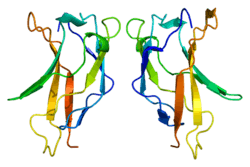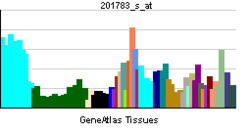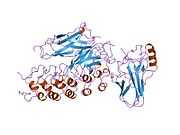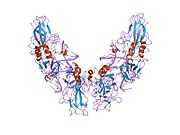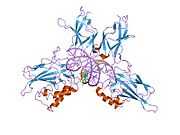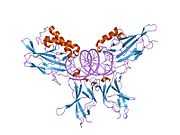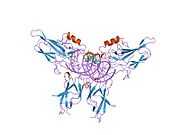RELA
Transcription factor p65 also known as nuclear factor NF-kappa-B p65 subunit is a protein that in humans is encoded by the RELA gene.[1]
RELA, also known as p65, is a REL-associated protein involved in NF-κB heterodimer formation, nuclear translocation and activation. NF-κB is an essential transcription factor complex involved in all types of cellular processes, including cellular metabolism, chemotaxis, etc. Phosphorylation and acetylation of RELA are crucial post-translational modifications required for NF-κB activation. RELA has also been shown to modulate immune responses, and activation of RELA is positively associated with multiple types of cancer.
Gene and expression
RELA, or v-rel avian reticuloendotheliosis viral oncogene homolog A, is also known as p65 or NFKB3.[2] It is located on chromosome 11 q13, and its nucleotide sequence is 1473 nucleotide long.[3] RelA protein has four isoforms, the longest and the predominant one being 551 amino acids. RELA is expressed alongside with p50 in various cell types, including epithelial/endothelial cells and neuronal tissues.[4]
Structure
RELA is one member of the NF-κB family, one of the most essential transcription factors under intensive study. Seven proteins encoded by five genes are involved in the NF-κB complex, namely p105, p100, p50, p52, RELA, c-REL and RELB.[5] Like other proteins in this complex, RELA contains a N-terminal REL-homology domain (RHD), and also a C-terminal transactivation domain(TAD). RHD is involved in DNA binding, dimerization and NF-κB/REL inhibitor interaction. On the other hand TAD is responsible for interacting with the basal transcription complex including many coactivators of transcription such as TBP, TFIIB and CREB-CBP.[5] RELA and p50 is the mostly commonly found heterodimer complex among NF-κB homodimers and heterodimers, and is the functional component participating in nuclear transclocation and activation of NF-κB.
Phosphorylation
Phosphorylation of RELA plays a key role in regulating NF-κB activation and function. Subsequent to NF-κB nuclear translocation, RELA undergoes site-specific post-translational modifications to further enhance the NF-κB function as a transcription factor. RELA can either be phosphorylated in the RHD region or the TAD region, attracting different interaction partners. Triggered by lipopolysaccharide, PKA specifically phosphorylates serine 276 in the RHD domain in the cytoplasm, controlling NF-κB DNA-binding and oligomerization.[5] On the other hand, mitogen and stress-activated kinase 1(MSK1) are also able to phosphorylate RELA at residue 276 under TNFα induction in the nucleus, increasing NF-κB response at the transcriptional level.[5] Phosphorylation of serine 311 by PKCζ serves the same purpose.[5] Two residues in the TAD region are targeted by phosphorylation. After IL1or TNFα stimulation, serine 529 is phosphorylated by casein kinase II (CKII), while serine 536 is phosphorylated by IκB kinases (IKKs)(4). Induced by p53, ribosomal subunit kinase-1 also has the ability to phosphorylate serine 536. A couple of other kinases are also able to phosphorylate RELA at different conditions, including glycogen-synthase kinase-3β (GSK3β), AKT/phosphatidylinositol 3-kinase (PI3K) and NF-κB activating kinase (NAK, i.e. TANK-binding kinase-1 (TBK1) and TRAF2-associated kinase (T2K)).[5] The fact that RELA can be modified by a collection of kinases via phosphorylation at different sites/regions within the protein under different stimulations might suggest a synergistic effect of the these modifications. Phosphorylation at these sites enhances NF-κB transcriptional response via tightened binding to transcription coactivators. For example, CBP and p300 binding to RELA are enhanced when serine 276 or 311 is phosphorylated.[5] Cell-type-specific phosphoryation is also observed for RELA. Multiple-site phosphorylation is common in endothelial cells, and different cell types may contain different stimuli, leading to targeted phosphorylation of RELA by different kinases. For instance, IKK2 is found to be mainly responsible for phosphorylating serine 536 in monocytes and macrophages, or in CD40 receptor binding in hepatic stellate cells.[4] IKK1 functions as the major kinase phosphoryating serine 536 under different stimuli, such as the ligand activation of the lymphotoxin-β receptor (LTβR).[4]
Acetylation
In vivo studies revealed that RELA is also under acetylation modification in the nucleus, which is just as important as phosphorylation as a post-translational modification of proteins. lysines 218, 221 and 310 are acetylation targets within RELA, and response to actylation is site-specific.[5] For instance, lysine 221 acetylation facilitates RELA dissociation from IκBα and enhances its DNA-binding affinity. Lysine 310 acetylation is indispensable for the full transcriptional activity of RELA, but does not affect its DNA-binding ability. Hypothesis about RELA acetylation suggests acetylation aids its subsequent recognition by transcriptional co-activators with bromodomains, which are specialized in recognizing acetylated lysine residues.[5] Lysine 122 and 123 acetylation are found to be negatively correlated with RELA transcriptional activation. Unknown mechanisms mediate the acetylation of RELA possibly using p300/CBP and p300/CBP factor associated coactivators under TNFα or phorbol myristate acetate (PMF) stimulation both in vivo and in vitro.[5] RELA is also under the control of deactylation via HDAC, and HDAC3 is the mediator of this process both in vivo and in vitro.[4][5]
Methylation
Methylation of K218 and K 221 together or K37 alone in the RHD domain of RELA can lead to increased response to cytokines such as IL-1 in mammalian cell culture.[6]
Interactions
As the prototypical heterodimer complex member of the NF-κB, together with p50, RELA/p65 interacts with various proteins in both the cytoplasm and in the nucleus during the process of classical NF-κB activation and nuclear translocation. In the inactive state, RELA/p50 complex is mainly sequestered by IκBα in the cytosol. TNFα, LPS and other factors serve as activation inducers, followed by phosphorylation at residue 32 and 36 of IκBα, leading to rapid degradation of IκBα via the ubiquitin-proteasomal system and subsequent release of RELA/p50 complex.[5] RELA nuclear localization signal used to be sequestered by IκBα is now exposed, and rapid translocation of the NF-κB occurs. In parallel, there is a non-classical NF-κB activation pathway involving the proteolytic cleavage of p100 into p52 instead of p50. This process does not require RELA, hence will not be discussed in detail here.[5] After NF-κB nuclear localization due to TNF stimulation, p50/RELA heterodimer will function as a transcription factor and bind to a variety of genes involved in all kinds of biological processes, such as leukocyte activation/chemotaxis, negative regulation of TNFIKK pathway, cellular metabolism, antigen processing, just to name a few .[7] Phosphorylation of RELA at different residues also enables its interaction with CDKs and P-TEFb. Phosphorylation at serine 276 in RELA allows its interaction with P-TEFb containing CDK-9 and cyclin T1 subunits, and phospho-ser276 RELA-P-TEFb complex is necessary for IL-8 and Gro-β activation.[7] Another mechanism is involved in the activation of genes preloaded with Pol II in a RELA ser 276 phosphorylation independent manner.
RELA has been shown to interact with:
- APBA2,[8]
- AHR,[9][10]
- ASCC3,[11]
- BRCA1,[12]
- BTRC,[13]
- C-Fos,[14]
- C-jun,[14]
- C22orf25,[15]
- CSNK2A1,[16]
- CDK9,[17]
- CEBPB,[18][19]
- CREBBP,[20][21][22][23][24]
- CSNK2A2,[16]
- DHX9,[25]
- EP300,[24][26]
- ETHE1,[27]
- FUS,[28]
- HDAC1,[21][26][29]
- HDAC2,[26][30]
- HDAC3,[31]
- ING4,[32]
- IκBα,[13][26][31][33][34][35][36]
- MEN1,[37]
- MTPN,[38]
- NCF1,[39]
- NFKB1,[40][41]
- NFKB2,[40][42]
- NFKBIB,[43][44]
- NFKBIE,[45]
- NR3C1,[46][47][48]
- NCOR2,[49][50]
- PARP1,[51]
- PIAS3,[20]
- POU2F1,[52]
- PPP1R13L,[53][54]
- PRKCZ,[55]
- REL,[34][40][56]
- RFC1,[57]
- RNF25,[58]
- SP1,[59][60]
- STAT3,[61][62]
- TAF4B,[63]
- TBP,[64][65]
- TP53,[62] and
- TRIB3.[66]
Role in immune system
Gene knockout of NF-κB genes via homologous recombination in mice showed the role of these components in innate and adaptive immune responses. RELA knockout mice is embryonic lethal due to liver apoptosis.[4] Lymphocyte activation failure is also observed, suggesting that RELA is indispensable in the proper development of the immune system. In comparison, deletion of other REL-related genes will not cause embryonic development failure, though different levels of defects are also noted.[4] The fact that cytokines such as TNFα and IL-1 can stimulate the activation of RELA also supports its participation in immune response. In general, RELA participates in adaptive immunity and responses to invading pathogens via NF-κB activation. Mice without individual NF-κB proteins are deficient in B- and T-cell activation and proliferation, cytoline production and isotype switching.[4] Mutations in RELA is found responsible for inflammatory bowel disease as well.[4]
Cancer
NF-κB/RELA activation has been found to be correlated with cancer development, suggesting the potential of RELA as a cancer biomarker. Specific modification patterns of RELA have also been observed in many cancer types.
Prostate
RELA may have a potential role as biomarker for prostate cancer progression and metastases, as suggested by the association found between RELA nuclear localization and prostate cancer aggressiveness and biochemical recurrence.[67]
Thyroid
Strong correlation between nuclear localization of RELA and clinicopathological parameters for papillary thyroid carcinoma (PTC), suggesting the role of NF-κB activation in tumor growth and aggressiveness in PTC.[68] Other than usage as an biomarker, serine 536 phosphorylation in RELA is also correlated with nuclear translocation and the expression of some transactivating genes such as COX-2, IL-8 and GST-pi in follicular thyroid carcinomas via morphoproteomic analysis.[69]
Leukemia
Mutations in the transactivation domain of RELA can lead to decrease in transactivating ability and this mutation can be found in lymphoid neoplasia.[70]
Head and Neck
Nuclear localization of NF-κB/RELA is positively correlated with tumor micrometastases into lymph and blood and negatively correlated with patient survival outcome in patients with head and neck squamous cell carcinoma (HNSCC).[71] This suggests a role of NF-κB/RELA as a possible target for targeted-therapy.
Breast
There is both a physical and a functional association between RELA and aryl hydrocarbon receptor (AhR), and the subsequent activation of c-myc gene transcription in breast cancer cells.[9] Another paper reported interactions between estrogen receptor(ER) and NF-κB members, including p50 and RELA. It is shown that ERα interacts with both p50 and RELA in vitro and in vivo, and RELA antibody can reduce ERα:ERE complex formation. The paper claims a mutual repression between ER and NF-κB.[72]
References
- ↑ Nolan GP, Ghosh S, Liou HC, Tempst P, Baltimore D (April 1991). "DNA binding and I kappa B inhibition of the cloned p65 subunit of NF-kappa B, a rel-related polypeptide". Cell 64 (5): 961–9. doi:10.1016/0092-8674(91)90320-X. PMID 2001591.
- ↑ "Homo sapiens p65 gene for p65 subunit of transcription factor NF-kappa". Nucleotide. National Center for Biotechnology Information (NCBI), U.S. National Library of Medicine.
- ↑ 4.0 4.1 4.2 4.3 4.4 4.5 4.6 4.7 Li Q, Verma IM (2002). "NF-kappaB regulation in the immune system". Nat. Rev. Immunol. 2 (10): 725–34. doi:10.1038/nri910. PMID 12360211.
- ↑ 5.0 5.1 5.2 5.3 5.4 5.5 5.6 5.7 5.8 5.9 5.10 5.11 5.12 Chen LF, Greene WC (2004). "Shaping the nuclear action of NF-kappaB". Nat. Rev. Mol. Cell Biol. 5 (5): 392–401. doi:10.1038/nrm1368. PMID 15122352.
- ↑ Lua,T., M. Yang, D. Huang, H. Wei, G. H. Ozer, G. Ghosh, and G. R. Stark. (2013) Role of lysine methylation of NF-κB in differential gene regulation. Proc Natl Acad Sci, 110(33):13510-5. PMID 23904479.
- ↑ 7.0 7.1 Nowak DE, Tian B, Jamaluddin M, Boldogh I, Vergara LA, Choudhary S, Brasier AR (2008). "RelA Ser276 phosphorylation is required for activation of a subset of NF-kappaB-dependent genes by recruiting cyclin-dependent kinase 9/cyclin T1 complexes". Mol. Cell. Biol. 28 (11): 3623–38. doi:10.1128/MCB.01152-07. PMC 2423290. PMID 18362169.
- ↑ Tomita S, Fujita T, Kirino Y, Suzuki T (April 2000). "PDZ domain-dependent suppression of NF-kappaB/p65-induced Abeta42 production by a neuron-specific X11-like protein". J. Biol. Chem. 275 (17): 13056–60. doi:10.1074/jbc.C000019200. PMID 10777610.
- ↑ 9.0 9.1 Kim DW, Gazourian L, Quadri S A, Romieu-Mourez R, Sherr D H, Sonenshein G E (November 2000). "The RelA NF-kappaB subunit and the aryl hydrocarbon receptor (AhR) cooperate to transactivate the c-myc promoter in mammary cells". Oncogene 19 (48): 5498–506. doi:10.1038/sj.onc.1203945. PMID 11114727.
- ↑ Ruby CE, Leid Mark, Kerkvliet Nancy I (September 2002). "2,3,7,8-Tetrachlorodibenzo-p-dioxin suppresses tumor necrosis factor-alpha and anti-CD40-induced activation of NF-kappaB/Rel in dendritic cells: p50 homodimer activation is not affected". Mol. Pharmacol. 62 (3): 722–8. doi:10.1124/mol.62.3.722. PMID 12181450.
- ↑ Jung D-J, Sung Hee-Sook, Goo Young-Wha, Lee Hyun Mi, Park Ok Ku, Jung Sung-Yun, Lim Janghoo, Kim Han-Jong, Lee Soo-Kyung, Kim Tae Sung, Lee Jae Woon, Lee Young Chul (July 2002). "Novel transcription coactivator complex containing activating signal cointegrator 1". Mol. Cell. Biol. 22 (14): 5203–11. doi:10.1128/MCB.22.14.5203-5211.2002. PMC 139772. PMID 12077347.
- ↑ Benezra M, Chevallier Nathalie, Morrison Debra J, MacLachlan Timothy K, El-Deiry Wafik S, Licht Jonathan D (July 2003). "BRCA1 augments transcription by the NF-kappaB transcription factor by binding to the Rel domain of the p65/RelA subunit". J. Biol. Chem. 278 (29): 26333–41. doi:10.1074/jbc.M303076200. PMID 12700228.
- ↑ 13.0 13.1 Spencer E, Jiang J, Chen Z J (February 1999). "Signal-induced ubiquitination of IkappaBalpha by the F-box protein Slimb/beta-TrCP". Genes Dev. 13 (3): 284–94. doi:10.1101/gad.13.3.284. PMC 316434. PMID 9990853.
- ↑ 14.0 14.1 Yang X, Chen Y, Gabuzda D (September 1999). "ERK MAP kinase links cytokine signals to activation of latent HIV-1 infection by stimulating a cooperative interaction of AP-1 and NF-kappaB". J. Biol. Chem. 274 (39): 27981–8. doi:10.1074/jbc.274.39.27981. PMID 10488148.
- ↑ "Molecular Interaction Database".
- ↑ 16.0 16.1 Wang D, Westerheide S D, Hanson J L, Baldwin A S (October 2000). "Tumor necrosis factor alpha-induced phosphorylation of RelA/p65 on Ser529 is controlled by casein kinase II". J. Biol. Chem. 275 (42): 32592–7. doi:10.1074/jbc.M001358200. PMID 10938077.
- ↑ Amini S, Clavo Anaira, Nadraga Yuri, Giordano Antonio, Khalili Kamel, Sawaya Bassel E (August 2002). "Interplay between cdk9 and NF-kappaB factors determines the level of HIV-1 gene transcription in astrocytic cells". Oncogene 21 (37): 5797–803. doi:10.1038/sj.onc.1205754. PMID 12173051.
- ↑ Weber M, Sydlik Carmen, Quirling Martina, Nothdurfter Caroline, Zwergal Andreas, Heiss Peter, Bell Susanne, Neumeier Dieter, Ziegler-Heitbrock H W Loms, Brand Korbinian (June 2003). "Transcriptional inhibition of interleukin-8 expression in tumor necrosis factor-tolerant cells: evidence for involvement of C/EBP beta". J. Biol. Chem. 278 (26): 23586–93. doi:10.1074/jbc.M211646200. PMID 12707271.
- ↑ Xia C, Cheshire J K, Patel H, Woo P (Dec 1997). "Cross-talk between transcription factors NF-kappa B and C/EBP in the transcriptional regulation of genes". Int. J. Biochem. Cell Biol. 29 (12): 1525–39. doi:10.1016/S1357-2725(97)00083-6. PMID 9570146.
- ↑ 20.0 20.1 Jang HD, Yoon Kwiyeom, Shin Young Joo, Kim Jaesang, Lee Soo Young (June 2004). "PIAS3 suppresses NF-kappaB-mediated transcription by interacting with the p65/RelA subunit". J. Biol. Chem. 279 (23): 24873–80. doi:10.1074/jbc.M313018200. PMID 15140884.
- ↑ 21.0 21.1 Zhong H, May Michael J, Jimi Eijiro, Ghosh Sankar (March 2002). "The phosphorylation status of nuclear NF-kappa B determines its association with CBP/p300 or HDAC-1". Mol. Cell 9 (3): 625–36. doi:10.1016/S1097-2765(02)00477-X. PMID 11931769.
- ↑ Parry GC, Mackman N (Dec 1997). "Role of cyclic AMP response element-binding protein in cyclic AMP inhibition of NF-kappaB-mediated transcription". J. Immunol. 159 (11): 5450–6. PMID 9548485.
- ↑ Aarnisalo P, Palvimo J J, Jänne O A (March 1998). "CREB-binding protein in androgen receptor-mediated signaling". PNAS 95 (5): 2122–7. doi:10.1073/pnas.95.5.2122. PMC 19270. PMID 9482849.
- ↑ 24.0 24.1 Gerritsen ME, Williams A J, Neish A S, Moore S, Shi Y, Collins T (April 1997). "CREB-binding protein/p300 are transcriptional coactivators of p65". PNAS 94 (7): 2927–32. doi:10.1073/pnas.94.7.2927. PMC 20299. PMID 9096323.
- ↑ Tetsuka T, Uranishi Hiroaki, Sanda Takaomi, Asamitsu Kaori, Yang Jiang-Ping, Wong-Staal Flossie, Okamoto Takashi (September 2004). "RNA helicase A interacts with nuclear factor kappaB p65 and functions as a transcriptional coactivator". Eur. J. Biochem. 271 (18): 3741–51. doi:10.1111/j.1432-1033.2004.04314.x. PMID 15355351.
- ↑ 26.0 26.1 26.2 26.3 Kiernan R, Brès Vanessa, Ng Raymond W M, Coudart Marie-Pierre, El Messaoudi Selma, Sardet Claude, Jin Dong-Yan, Emiliani Stephane, Benkirane Monsef (January 2003). "Post-activation turn-off of NF-kappa B-dependent transcription is regulated by acetylation of p65". J. Biol. Chem. 278 (4): 2758–66. doi:10.1074/jbc.M209572200. PMID 12419806.
- ↑ Higashitsuji H, Higashitsuji Hiroaki, Nagao Toshikazu, Nonoguchi Kohsuke, Fujii Shingo, Itoh Katsuhiko, Fujita Jun (October 2002). "A novel protein overexpressed in hepatoma accelerates export of NF-kappa B from the nucleus and inhibits p53-dependent apoptosis". Cancer Cell 2 (4): 335–46. doi:10.1016/S1535-6108(02)00152-6. PMID 12398897.
- ↑ Uranishi H, Tetsuka T, Yamashita M, Asamitsu K, Shimizu M, Itoh M, Okamoto T (April 2001). "Involvement of the pro-oncoprotein TLS (translocated in liposarcoma) in nuclear factor-kappa B p65-mediated transcription as a coactivator". J. Biol. Chem. 276 (16): 13395–401. doi:10.1074/jbc.M011176200. PMID 11278855.
- ↑ Ashburner BP, Westerheide S D, Baldwin A S (October 2001). "The p65 (RelA) subunit of NF-kappaB interacts with the histone deacetylase (HDAC) corepressors HDAC1 and HDAC2 to negatively regulate gene expression". Mol. Cell. Biol. 21 (20): 7065–77. doi:10.1128/MCB.21.20.7065-7077.2001. PMC 99882. PMID 11564889.
- ↑ Yu Z, Zhang Wenzheng, Kone Bruce C (August 2002). "Histone deacetylases augment cytokine induction of the iNOS gene". J. Am. Soc. Nephrol. 13 (8): 2009–17. doi:10.1097/01.ASN.0000024253.59665.F1. PMID 12138131.
- ↑ 31.0 31.1 "Duration of nuclear NF-kappaB action regulated by reversible acetylation". Science 293 (5535): 1653–7. August 2001. doi:10.1126/science.1062374. PMID 11533489.
- ↑ Garkavtsev I, Kozin Sergey V, Chernova Olga, Xu Lei, Winkler Frank, Brown Edward, Barnett Gene H, Jain Rakesh K (March 2004). "The candidate tumour suppressor protein ING4 regulates brain tumour growth and angiogenesis". Nature 428 (6980): 328–32. doi:10.1038/nature02329. PMID 15029197.
- ↑ Hay DC, Kemp G D, Dargemont C, Hay R T (May 2001). "Interaction between hnRNPA1 and IkappaBalpha is required for maximal activation of NF-kappaB-dependent transcription". Mol. Cell. Biol. 21 (10): 3482–90. doi:10.1128/MCB.21.10.3482-3490.2001. PMC 100270. PMID 11313474.
- ↑ 34.0 34.1 Hansen SK, Baeuerle P A, Blasi F (April 1994). "Purification, reconstitution, and I kappa B association of the c-Rel-p65 (RelA) complex, a strong activator of transcription". Mol. Cell. Biol. 14 (4): 2593–603. doi:10.1128/mcb.14.4.2593. PMC 358627. PMID 8139561.
- ↑ Malek S, Huxford T, Ghosh G (September 1998). "Ikappa Balpha functions through direct contacts with the nuclear localization signals and the DNA binding sequences of NF-kappaB". J. Biol. Chem. 273 (39): 25427–35. doi:10.1074/jbc.273.39.25427. PMID 9738011.
- ↑ Cohen L, Henzel W J, Baeuerle P A (September 1998). "IKAP is a scaffold protein of the IkappaB kinase complex". Nature 395 (6699): 292–6. doi:10.1038/26254. PMID 9751059.
- ↑ Heppner C, Bilimoria K Y, Agarwal S K, Kester M, Whitty L J, Guru S C, Chandrasekharappa S C, Collins F S, Spiegel A M, Marx S J, Burns A L (August 2001). "The tumor suppressor protein menin interacts with NF-kappaB proteins and inhibits NF-kappaB-mediated transactivation". Oncogene 20 (36): 4917–25. doi:10.1038/sj.onc.1204529. PMID 11526476.
- ↑ Knuefermann P, Chen Peter, Misra Arunima, Shi Shu-Ping, Abdellatif Maha, Sivasubramanian Natarajan (June 2002). "Myotrophin/V-1, a protein up-regulated in the failing human heart and in postnatal cerebellum, converts NFkappa B p50-p65 heterodimers to p50-p50 and p65-p65 homodimers". J. Biol. Chem. 277 (26): 23888–97. doi:10.1074/jbc.M202937200. PMID 11971907.
- ↑ Gu Y, Xu You Cheng, Wu Ru Feng, Nwariaku Fiemu E, Souza Rhonda F, Flores Sonia C, Terada Lance S (May 2003). "p47phox participates in activation of RelA in endothelial cells". J. Biol. Chem. 278 (19): 17210–7. doi:10.1074/jbc.M210314200. PMID 12618429.
- ↑ 40.0 40.1 40.2 Bouwmeester T, Bauch Angela, Ruffner Heinz, Angrand Pierre-Olivier, Bergamini Giovanna, Croughton Karen, Cruciat Cristina, Eberhard Dirk, Gagneur Julien, Ghidelli Sonja, Hopf Carsten, Huhse Bettina, Mangano Raffaella, Michon Anne-Marie, Schirle Markus, Schlegl Judith, Schwab Markus, Stein Martin A, Bauer Andreas, Casari Georg, Drewes Gerard, Gavin Anne-Claude, Jackson David B, Joberty Gerard, Neubauer Gitte, Rick Jens, Kuster Bernhard, Superti-Furga Giulio (February 2004). "A physical and functional map of the human TNF-alpha/NF-kappa B signal transduction pathway". Nat. Cell Biol. 6 (2): 97–105. doi:10.1038/ncb1086. PMID 14743216.
- ↑ Palvimo JJ, Reinikainen P, Ikonen T, Kallio P J, Moilanen A, Jänne O A (September 1996). "Mutual transcriptional interference between RelA and androgen receptor". J. Biol. Chem. 271 (39): 24151–6. doi:10.1074/jbc.271.39.24151. PMID 8798655.
- ↑ Scheinman RI, Beg A A, Baldwin A S (October 1993). "NF-kappa B p100 (Lyt-10) is a component of H2TF1 and can function as an I kappa B-like molecule". Mol. Cell. Biol. 13 (10): 6089–101. PMC 364669. PMID 8413211.
- ↑ Chen Y, Wu Joann, Ghosh Gourisankar (June 2003). "KappaB-Ras binds to the unique insert within the ankyrin repeat domain of IkappaBbeta and regulates cytoplasmic retention of IkappaBbeta x NF-kappaB complexes". J. Biol. Chem. 278 (25): 23101–6. doi:10.1074/jbc.M301021200. PMID 12672800.
- ↑ Suyang H, Phillips R, Douglas I, Ghosh S (October 1996). "Role of unphosphorylated, newly synthesized I kappa B beta in persistent activation of NF-kappa B". Mol. Cell. Biol. 16 (10): 5444–9. PMC 231544. PMID 8816457.
- ↑ Li Z, Nabel G J (October 1997). "A new member of the I kappaB protein family, I kappaB epsilon, inhibits RelA (p65)-mediated NF-kappaB transcription". Mol. Cell. Biol. 17 (10): 6184–90. PMC 232469. PMID 9315679.
- ↑ Ray A, Prefontaine K E (January 1994). "Physical association and functional antagonism between the p65 subunit of transcription factor NF-kappa B and the glucocorticoid receptor". PNAS 91 (2): 752–6. doi:10.1073/pnas.91.2.752. PMC 43027. PMID 8290595.
- ↑ Nissen RM, Yamamoto K R (September 2000). "The glucocorticoid receptor inhibits NFkappaB by interfering with serine-2 phosphorylation of the RNA polymerase II carboxy-terminal domain". Genes Dev. 14 (18): 2314–29. doi:10.1101/gad.827900. PMC 316928. PMID 10995388.
- ↑ Caldenhoven E, Liden J, Wissink S, Van de Stolpe A, Raaijmakers J, Koenderman L, Okret S, Gustafsson J A, Van der Saag P T (April 1995). "Negative cross-talk between RelA and the glucocorticoid receptor: a possible mechanism for the antiinflammatory action of glucocorticoids". Mol. Endocrinol. 9 (4): 401–12. doi:10.1210/me.9.4.401. PMID 7659084.
- ↑ Espinosa Lí, Inglés-Esteve Julia, Robert-Moreno Alex, Bigas Anna (February 2003). "IkappaBalpha and p65 regulate the cytoplasmic shuttling of nuclear corepressors: cross-talk between Notch and NFkappaB pathways". Mol. Biol. Cell 14 (2): 491–502. doi:10.1091/mbc.E02-07-0404. PMC 149987. PMID 12589049.
- ↑ Lee SK, Kim J H, Lee Y C, Cheong J, Lee J W (April 2000). "Silencing mediator of retinoic acid and thyroid hormone receptors, as a novel transcriptional corepressor molecule of activating protein-1, nuclear factor-kappaB, and serum response factor". J. Biol. Chem. 275 (17): 12470–4. doi:10.1074/jbc.275.17.12470. PMID 10777532.
- ↑ Hassa PO, Covic M, Hasan S, Imhof R, Hottiger M O (Dec 2001). "The enzymatic and DNA binding activity of PARP-1 are not required for NF-kappa B coactivator function". J. Biol. Chem. 276 (49): 45588–97. doi:10.1074/jbc.M106528200. PMID 11590148.
- ↑ van Heel DA, Udalova Irina A, De Silva Arjuna P, McGovern Dermot P, Kinouchi Yoshitaka, Hull Jeremy, Lench Nicholas J, Cardon Lon R, Carey Alisoun H, Jewell Derek P, Kwiatkowski Dominic (May 2002). "Inflammatory bowel disease is associated with a TNF polymorphism that affects an interaction between the OCT1 and NF(-kappa)B transcription factors". Hum. Mol. Genet. 11 (11): 1281–9. doi:10.1093/hmg/11.11.1281. PMID 12019209.
- ↑ Yang JP, Hori M, Sanda T, Okamoto T (May 1999). "Identification of a novel inhibitor of nuclear factor-kappaB, RelA-associated inhibitor". J. Biol. Chem. 274 (22): 15662–70. doi:10.1074/jbc.274.22.15662. PMID 10336463.
- ↑ Takada N, Sanda Takaomi, Okamoto Hiroshi, Yang Jian-Ping, Asamitsu Kaori, Sarol Lilen, Kimura Genjiro, Uranishi Hiroaki, Tetsuka Toshifumi, Okamoto Takashi (August 2002). "RelA-associated inhibitor blocks transcription of human immunodeficiency virus type 1 by inhibiting NF-kappaB and Sp1 actions". J. Virol. 76 (16): 8019–30. doi:10.1128/JVI.76.16.8019-8030.2002. PMC 155123. PMID 12134007.
- ↑ Leitges M, Sanz L, Martin P, Duran A, Braun U, García J F, Camacho F, Diaz-Meco M T, Rennert P D, Moscat J (October 2001). "Targeted disruption of the zetaPKC gene results in the impairment of the NF-kappaB pathway". Mol. Cell 8 (4): 771–80. doi:10.1016/S1097-2765(01)00361-6. PMID 11684013.
- ↑ Liss AS, Bose Henry R (May 2002). "Mutational analysis of the v-Rel dimerization interface reveals a critical role for v-Rel homodimers in transformation". J. Virol. 76 (10): 4928–39. doi:10.1128/JVI.76.10.4928-4939.2002. PMC 136140. PMID 11967310.
- ↑ Anderson LA, Perkins Neil D (January 2003). "Regulation of RelA (p65) function by the large subunit of replication factor C". Mol. Cell. Biol. 23 (2): 721–32. doi:10.1128/MCB.23.2.721-732.2003. PMC 151544. PMID 12509469.
- ↑ Asamitsu K, Tetsuka Toshifumi, Kanazawa Satoshi, Okamoto Takashi (July 2003). "RING finger protein AO7 supports NF-kappaB-mediated transcription by interacting with the transactivation domain of the p65 subunit". J. Biol. Chem. 278 (29): 26879–87. doi:10.1074/jbc.M211831200. PMID 12748188.
- ↑ Kuang P-P, Berk John L, Rishikof David C, Foster Judith A, Humphries Donald E, Ricupero Dennis A, Goldstein Ronald H (July 2002). "NF-kappaB induced by IL-1beta inhibits elastin transcription and myofibroblast phenotype". Am. J. Physiol., Cell Physiol. 283 (1): C58–65. doi:10.1152/ajpcell.00314.2001. PMID 12055073.
- ↑ Sif S, Gilmore T D (November 1994). "Interaction of the v-Rel oncoprotein with cellular transcription factor Sp1". J. Virol. 68 (11): 7131–8. PMC 237152. PMID 7933095.
- ↑ Yu Z, Zhang Wenzheng, Kone Bruce C (October 2002). "Signal transducers and activators of transcription 3 (STAT3) inhibits transcription of the inducible nitric oxide synthase gene by interacting with nuclear factor kappaB". Biochem. J. 367 (Pt 1): 97–105. doi:10.1042/BJ20020588. PMC 1222853. PMID 12057007.
- ↑ 62.0 62.1 Choy MK, Movassagh M, Siggens L, Vujic A, Goddard M, Sánchez A, Perkins N, Figg N, Bennett M, Carroll J, Foo R. High-throughput sequencing identifies STAT3 as the DNA-associated factor for p53-NF-kappaB-complex-dependent gene expression in human heart failure. Genome Medicine. 2010;6(2):37. doi:10.1186/gm158. PMID 20546595.
- ↑ Yamit-Hezi A, Dikstein R (September 1998). "TAFII105 mediates activation of anti-apoptotic genes by NF-kappaB". EMBO J. 17 (17): 5161–9. doi:10.1093/emboj/17.17.5161. PMC 1170844. PMID 9724652.
- ↑ Guermah M, Malik S, Roeder R G (June 1998). "Involvement of TFIID and USA components in transcriptional activation of the human immunodeficiency virus promoter by NF-kappaB and Sp1". Mol. Cell. Biol. 18 (6): 3234–44. PMC 108905. PMID 9584164.
- ↑ Schmitz ML, Stelzer G, Altmann H, Meisterernst M, Baeuerle P A (March 1995). "Interaction of the COOH-terminal transactivation domain of p65 NF-kappa B with TATA-binding protein, transcription factor IIB, and coactivators". J. Biol. Chem. 270 (13): 7219–26. doi:10.1074/jbc.270.13.7219. PMID 7706261.
- ↑ Wu M, Xu Liang-Guo, Zhai Zhonghe, Shu Hong-Bing (July 2003). "SINK is a p65-interacting negative regulator of NF-kappaB-dependent transcription". J. Biol. Chem. 278 (29): 27072–9. doi:10.1074/jbc.M209814200. PMID 12736262.
- ↑ Gannon PO, Lessard L, Stevens LM, Forest V, Bégin LR, Minner S, Tennstedt P, Schlomm T, Mes-Masson AM, Saad F (2013). "Large-scale independent validation of the nuclear factor-kappa B p65 prognostic biomarker in prostate cancer". Eur. J. Cancer 49 (10): 2441–8. doi:10.1016/j.ejca.2013.02.026. PMID 23541563.
- ↑ Pyo JS, Kang G, Kim DH, Chae SW, Park C, Kim K, Do SI, Lee HJ, Kim JH, Sohn JH (2013). "Activation of nuclear factor-κB contributes to growth and aggressiveness of papillary thyroid carcinoma". Pathol. Res. Pract. 209 (4): 228–32. doi:10.1016/j.prp.2013.02.004. PMID 23528368.
- ↑ Liu J, Brown RE (2012). "Morphoproteomic confirmation of an activated nuclear factor-кBp65 pathway in follicular thyroid carcinoma". Int J Clin Exp Pathol 5 (3): 216–23. PMC 3341672. PMID 22558476.
- ↑ Trecca D, Guerrini L, Fracchiolla NS, Pomati M, Baldini L, Maiolo AT, Neri A (February 1997). "Identification of a tumor-associated mutant form of the NF-kappaB RelA gene with reduced DNA-binding and transactivating activities". Oncogene 14 (7): 791–9. doi:10.1038/sj.onc.1200895. PMID 9047386.
- ↑ Balermpas P, Michel Y, Wagenblast J, Seitz O, Sipek F, Rödel F, Rödel C, Fokas E (2013). "Nuclear NF-κB expression correlates with outcome among patients with head and neck squamous cell carcinoma treated with primary chemoradiation therapy". Int. J. Radiat. Oncol. Biol. Phys. 86 (4): 785–90. doi:10.1016/j.ijrobp.2013.04.001. PMID 23664323.
- ↑ Gionet N, Jansson D, Mader S, Pratt MA (2009). "NF-kappaB and estrogen receptor alpha interactions: Differential function in estrogen receptor-negative and -positive hormone-independent breast cancer cells". J. Cell. Biochem. 107 (3): 448–59. doi:10.1002/jcb.22141. PMID 19350539.
Further reading
- Baldwin AS (1996). "The NF-kappa B and I kappa B proteins: new discoveries and insights.". Annu. Rev. Immunol. 14: 649–83. doi:10.1146/annurev.immunol.14.1.649. PMID 8717528.
- Bottex-Gauthier C, Pollet S, Favier A, Vidal DR (2002). "[The Rel/NF-kappa-B transcription factors: complex role in cell regulation]". Pathol. Biol. 50 (3): 204–11. doi:10.1016/s0369-8114(02)00289-4. PMID 11980335.
- Garg A, Aggarwal BB (2002). "Nuclear transcription factor-kappaB as a target for cancer drug development.". Leukemia 16 (6): 1053–68. doi:10.1038/sj.leu.2402482. PMID 12040437.
- Clarke R, Liu MC, Bouker KB et al. (2003). "Antiestrogen resistance in breast cancer and the role of estrogen receptor signaling.". Oncogene 22 (47): 7316–39. doi:10.1038/sj.onc.1206937. PMID 14576841.
External links
- RELA protein, human at the US National Library of Medicine Medical Subject Headings (MeSH)
| |||||||||||||||||||||||||||||||||||
| ||||||||||||||||||||||||||||||||||||||||||||||||||||||||||||||||||||||||||||||||||||||||||||||||||||||||||||||||||||||||||||||||||||||||||||||||||||||||||||||||||||||||||||||||||||||||||||||||||||||||||||||
